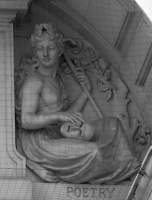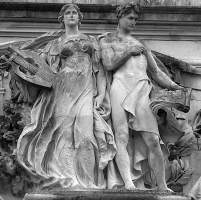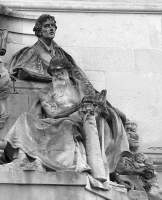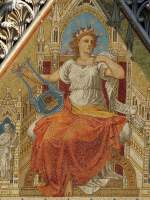
Ideal figures of Poetry are not as common as we might expect, or they are perhaps not as recognisable as such as to allow us to spot them! Rather, I think, instead of an allegorical figure of Poetry per se, an actual poet is often chosen instead – Virgil, for example, or Dante. But here are a few examples of Poetry figures for our series.
Poetry can be female or male, and a nice example of the female version is at the top of this page – one of the series of figures on the old City of London School by J. Daymond. She is a refined, civilised figure in Classical vein, as she should be, holding a shepherd’s crook, presumably to marshall her thoughts, and on her lap cradles a mask of tragedy, as this is the way much poetry tends. Behind her an old tree sends forth a new sprig of foliage, suggestive of inspiration, and a poppy in the corner indicates the subconscious mind. She wears a wreath, indicating the high status of Poetry. Her exposed full breast suggests fruitfulness, i.e. of the poetical imagination.
A contrasting and more conventional figure is The Genius of Poetry by Thomas Brock. He is a nearly nude male figure, Apollo-like (Apollo was god of poetry as well as music, the sun etc), holding a sheaf of paper and pencil, posed with a thoughtful, almost troubled expression. Around the base are faces and a snake, presumably indicative of half formed thoughts emerging from the Poet’s mind.

 Montford's poetic figures for Cardiff.
Montford's poetic figures for Cardiff.
A figure presumably inspired by Brock’s one, and rather similar in pose and dress, is this one by Paul Montford, used as part of a group of Music and Poetry on Cardiff’s City Hall, along with a Byronic figure and an ancient, the latter with heavy parchment, classical pillar, and roses to indicate budding thoughts.
Above is a simple classical female figure of Poetry, part of a procession with the other Arts, holding a book. Another simple Poetry figure is the young boy below, one of a pair with Prose, head bowed in thought above his poetical work, with ripening fruit and flowers in a large vase behind him.
As often the case with allegorical sculptural figures, we can have a nude without accoutrements, who illustrates the desired qualities through her expression and pose. This one, Lyrical Poetry, is seated on a lion, rather like more familiar figures of Una or perhaps Ariadne, and it is the poise of her head that intends to give the sense of the lyrical, together with her pure, unclad state.
Our second example of the nude Poetry is by F. W. Pomeroy, an archetypical New Sculpture figure of a girl, hand to her breast holding a flower, head turned to one side, her gaze to the distance but lost in inner thought. She stands on a little vegetative mound, perhaps indicative of cast aside thoughts, or alternatively of other blossomings yet to be picked.
Finally, the Albert Memorial, an obvious spot for an allegorical Poetry statue, does not in fact have one, as she is the subject of one of the four Salviati mosaics on the pediments of the structure: here she is, with lyre - symbol of Apollo again - and about her arm a list of some famous poets.
 Mosaic on the Albert Memorial showing Poetry.
Mosaic on the Albert Memorial showing Poetry.
Back to Allegorical sculpture - O // Onward to Allegorical sculpture - R // Full Alphabet of Allegorical sculpture
Sculpture in London // Sculpture in England // Sculptors
Visits to this page from 16 Apr 2012: 6,647